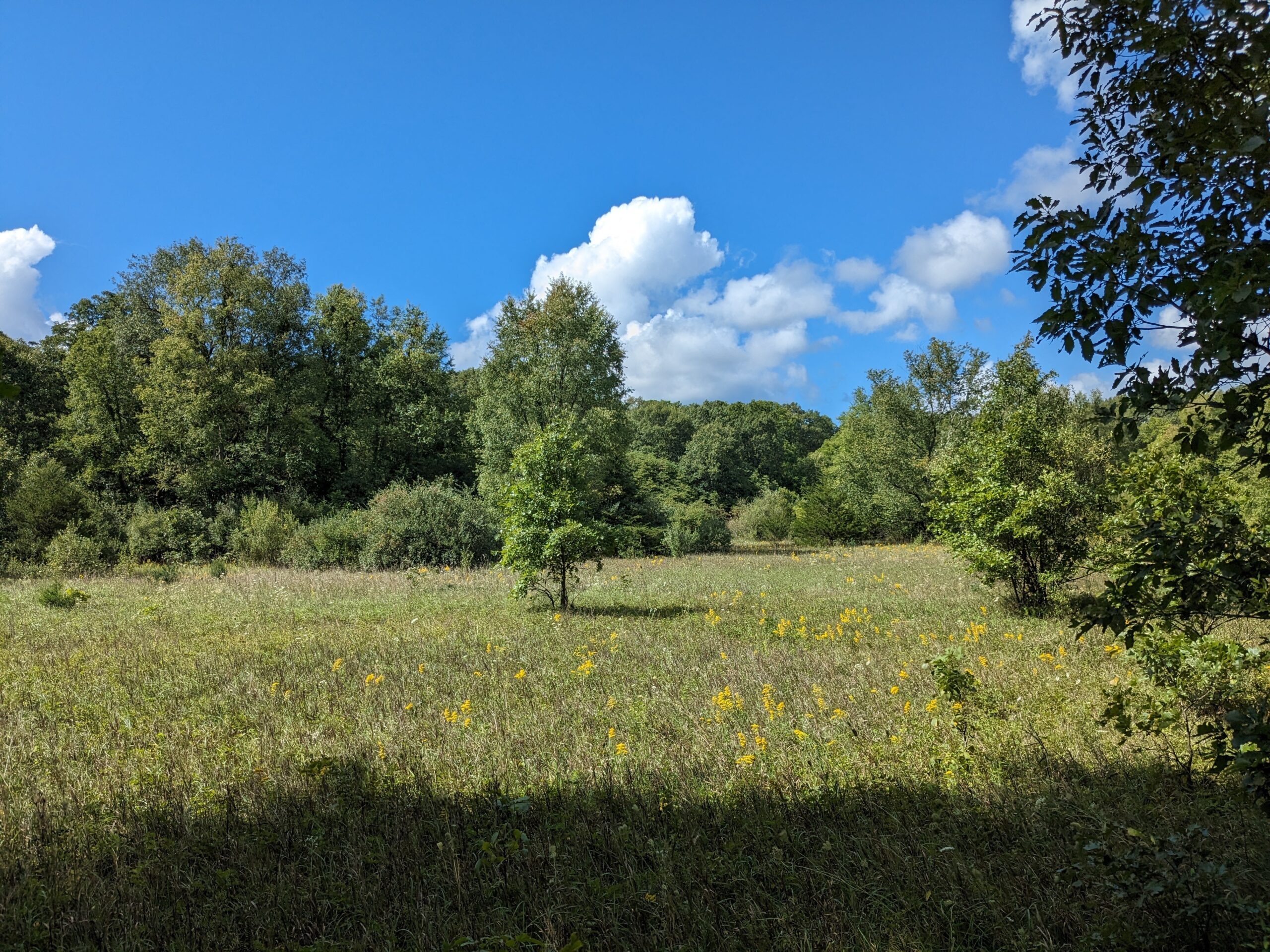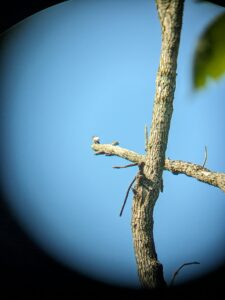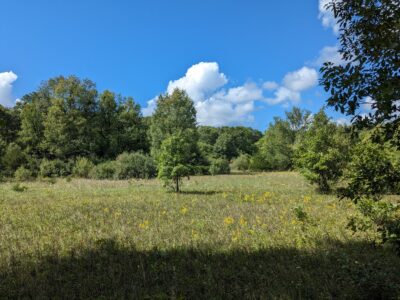Conservation Manager Chad Machinski, M.S., joined the Michigan Audubon team in March and has made great progress in reviving the stewardship of MA’s sanctuaries and engaging with our dedicated volunteers ever since. To help you stay connected with the work being done, he will be presenting regular online updates about activities going on at them: birds seen or heard, conservation work, improvements, interesting plants, and more.
VOORHEES BROTHERS MEMORIAL SANCTUARY
Voorhees Brothers Memorial Sanctuary is a special little sanctuary. Measuring in at about 40 acres, this site in Albion, Mich., made my jaw drop when I first visited back in the spring. Once you get through the narrow little right of way and the decrepit boardwalks (hopefully getting replaced in 2024!), you are thrust into a dry-mesic southern forest almost entirely void of non-native, invasive species. In the few times I’ve visited, not a garlic mustard or dame’s rocket leaf has been observed, no autumn olive, no honeysuckles, and so few multiflora rose and Japanese barberry that I could count them all on one hand. I thank prior efforts from my predecessors and volunteers for this! As I traversed the site, making sure I understood where our property boundaries lay, the only herbaceous, non-native, invasive plant beginning to move in from the edges was Japanese hedge parsley, one that I’ll be sure to work on pulling in the following year.
On my first visit to the site back in the spring, I met up with our sanctuary steward, Ian MacInnes. Much to my surprise, he informed me that he had seen Red-headed Woodpeckers here before. I was shocked to hear this, as this wouldn’t fit what I consider to be good habitat for them. On my future visits, it was always in the back of my mind, and on this trip, as I made my way along the western boundary, I started to hear quite a racket up in the canopy of a few oaks. I moved closer, now standing on the log of an elm that probably once stood at the edge of this now-dried vernal pool. Looking up at a group of snags, I noticed a little lump at the end of a branch. At first glance, this could’ve just been a few mushrooms growing from the rotting wood, but I pulled the binoculars up, saw the half-white wings, and knew I was looking at a Red-headed Woodpecker. In addition, this was a juvenile as it had not yet developed its red head but was instead a dingy gray. I ended up getting eyes on one adult and heard at least one other calling. After watching them call and fly around the snags for a while, I moved on; I had plants to look at and boundaries to find.
I moved through the rest of the sanctuary, documenting the abundant vegetation in drawn-down vernal pools, such as cardinal flower, Gray’s sedge, hop sedge, buttonbush, and more. I found the property boundaries via our neighbor’s signs and realized the reason the Red-headed Woodpeckers likely hang around. There appears to be some selective logging happening directly adjacent to us, creating a pretty open forest, which may be the draw for these birds.
Voorhees, along with many of our sanctuaries, is a hidden gem. While the trail is short currently, there may be opportunities for expanding it. If you visit, I encourage all to use the boot brush station at the trailhead; it’s certainly a beautiful site, and we’d all love to keep it that way.
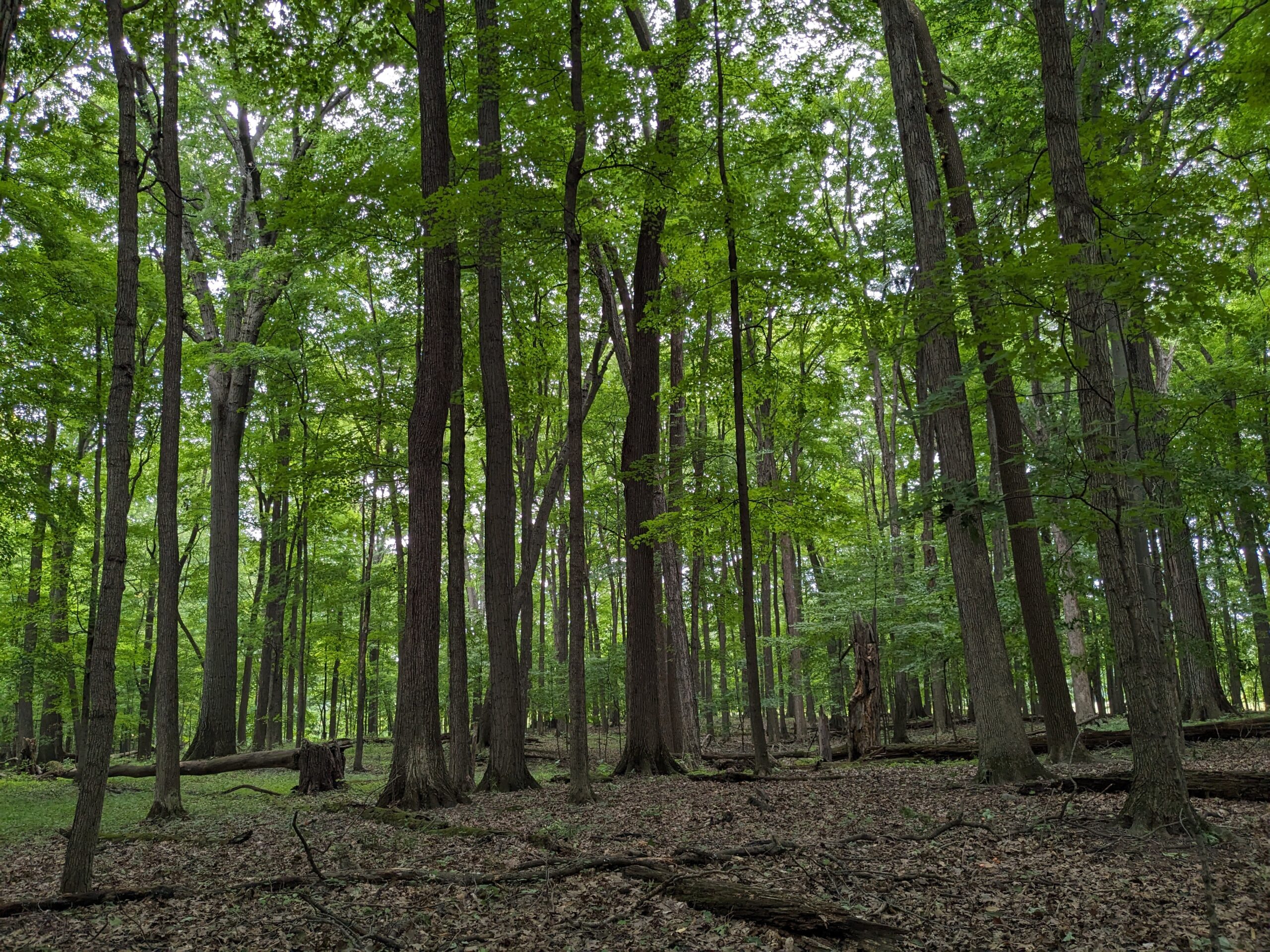
Voorhees Brothers Memorial Sanctuary. Photo by Chad Machinski
BERNARD W. BAKER SANCTUARY
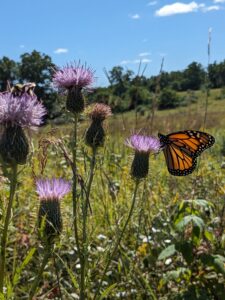
Bernard Baker Sanctuary 8/30/23. Monarch on Pasture Thistle (Cirsium bicolor). Photo by Chad Machinski
The following day, I visited our other property in Calhoun County, Bernard W. Baker Sanctuary. I covered some history of Baker in my previous post, so I won’t touch on it here; otherwise, I’ll be cutting it close to writing a novel with this blog post. Because our desired state with some areas of Baker is a prairie and oak savanna, a prescribed burn is being contracted out and will be completed in November. This later time of year allows some of our reptilian species that occupy this site to be hunkered down for the winter, protected from the burn. We are not burning a large area this year, but I wanted to clear much of the dense areas of autumn olive in the unit so that the burn can carry more easily through the space. With luck, any stems I missed treating with herbicide or stems that did not get sufficiently covered with herbicide will have time to re-sprout before the burn and then be knocked back when the burn comes through. Late summer and fall is the time to shine for the prairies. Some of the native plants that were on full display were compass plant, pasture thistle, swamp thistle, and big bluestem. More asters have surely opened up since I was last there, adding dashes of purple to the fall palette of browns and golds.
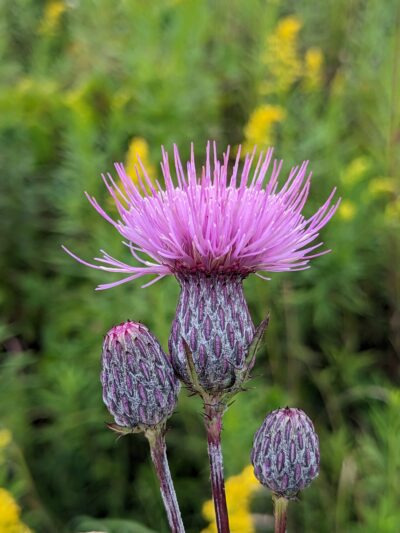
Bernard Baker Sanctuary. 8/30/23. Swamp Thistle (Cirsium muticum). Photo by Chad Machinski
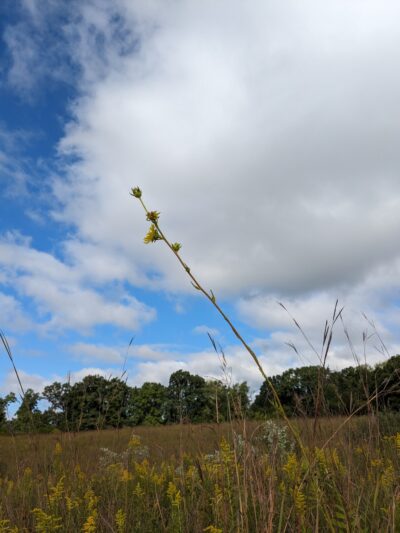
Bernard Baker Santuary. 8/30/23. Compass Plant (Silphium laciniatum). Photo by Chad Machinski
CAPITAL CITY BIRD SANCTUARY
If you were in the southern part of the state at the end of August, you likely experienced or knew someone who experienced the severe storms that came through. While most of our sanctuaries were spared significant damage, our Capital City Bird Sanctuary had 20-30 trees/branches come down onto the trails. Fortunately, we have a great group of volunteers who assisted in the cleanup of the trails, making them accessible again. It was a solid day of work with volunteers Paul Bielawski and Charlene Avery; I ran the chainsaw for much of the day, and they helped haul debris and cut smaller things out of the way with handsaws and loppers. It would have taken much more time had I not had that help; many hands truly make light work.
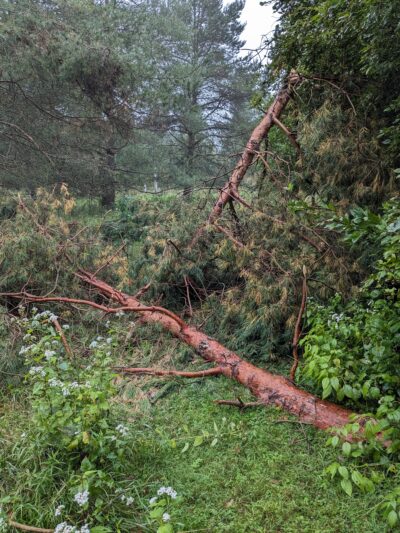
Capital City Bird Sanctuary. Photo by Chad Machinski
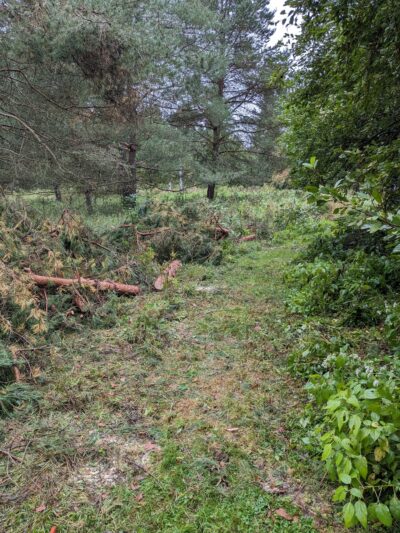
Capital City Bird Sanctuary. Photo by Chad Machinski
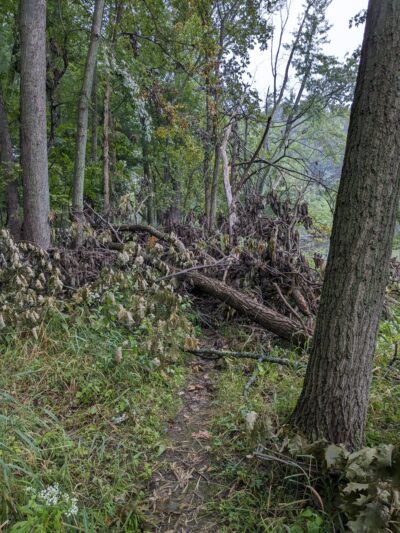
Capital City Bird Sanctuary. Photo by Chad Machinski
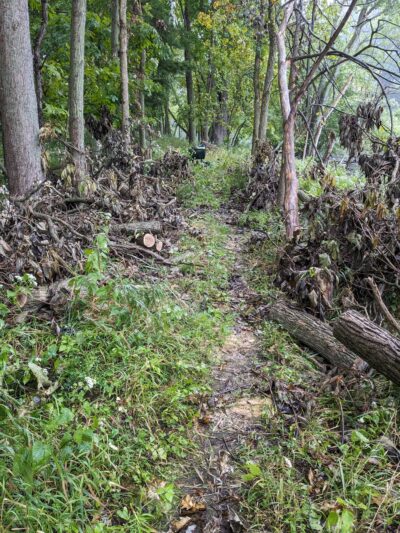
Capital City Bird Sanctuary. Photo by Chad Machinski
MARTHA MOTT SANCTUARY
In early September, I found myself at our Martha Mott Sanctuary in Mattawan. I don’t want to play favorites with our sanctuaries, but this 80-acre sanctuary has captivated me since I first visited in early spring with Sanctuary Steward Ellie Klemm. Donated to Michigan Audubon by Charles Mott (co-founder of the now defunct Be-Mo Potato Chip Company) and three relatives in 1971, not much is known about the history of the site prior to Mott’s ownership except that it had been partially grazed and that grapes and various vegetables were grown. The pre-settlement vegetation map suggests that this site, which rises from Hayden Creek to very level topography, was an oak savanna-like ecosystem – in my opinion, most likely an oak barren. Although quite degraded, there are still subtle aspects of this possible past present now if one inspects the vegetation and the soils – American columbo, a forest dominated by black and white oaks (dominant trees of an oak barren), spotted horsemint, sandy soils with stunted herbaceous vegetation in the open fields, the list goes on.
A 1977 bird survey published in the Jack Pine Warbler done by David Good presents some very interesting results. Some of the most interesting finds at Mott between May and July 1977 included nesting Red-tailed Hawks, nesting Ruffed Grouse, Northern Bobwhite, nesting American Woodcock, nesting Great Horned Owl, four pairs of Red-headed Woodpecker, and Eastern Meadowlark. Undoubtedly, this array of species can be related to the quite undeveloped surrounding lands at this time.
Fast forward to Sept. 12, 2023, and I’m at the sanctuary meeting with the U.S. Fish & Wildlife Service to discuss grant opportunities to restore some of the sanctuary to a state void of the autumn olive that is now encroaching on the fields and to reduce the smooth brome grass present as well. Later that morning, I have my first significant volunteer workday there, adding some folks who normally volunteer with Southwest Michigan Land Conservancy. We make a dent in the autumn olive, but more work will be needed. In addition, I will meet with a Michigan Bluebird Society representative in early October to see if the site meets the requirements for a nest box grant from them so that we can replace the aging nest boxes there. Only about two nest boxes are usable of the approximately eight that had historically been there, and one did produce a successful clutch of bluebirds and was monitored by volunteer and sanctuary neighbor Derek Haroldson.
Keep your eye on Martha Mott Sanctuary. This underdog sanctuary has significant potential to be a prime example of an oak barren. The eBird list boasts 145 species, historical records included, and volunteer Derek Haroldson is running away as the top eBirder with 117 species recorded.
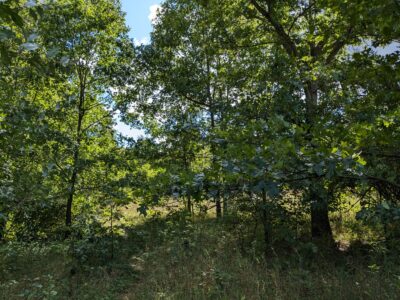
Martha Mott Sanctuary 9/12/23. Unit 1 under a cluster of Black Oaks. Photo by Chad Machinski
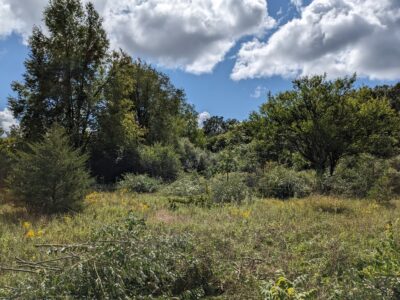
Martha Mott Sanctuary 9/12/23. Unit 1 looking southwest from north section. This is after cutting and piling Autumn Olive. Photo by Chad Machinski
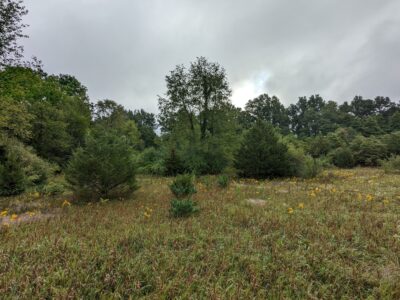
Martha Mott Sanctuay 9/12/23. Unit 1 field looking Southeast. Photo by Chad Machinski
CHIMNEY SWIFTS
I almost forgot! Chimney Swifts! Chimney Swifts have been grouping up and communally roosting for the past two months as they begin their southward journey. Over a few nights, I have observed three chimneys in the Lansing area and have gotten at least one swift entering each chimney. While some chimneys have records of upwards of 2,000 swifts entering to hunker down for the night, I have only been lucky enough to count 19 entering in one night. If you have an open chimney nearby, please check to see if any swifts are using them as a roost. It is certainly slowing down for the season, but as of Sept. 20, I still counted two swifts entering the chimney at the local middle school. Oftentimes, you will hear them before they enter your viewing area. I think of their call as a trickle of chirps and always hear them behind me for some time before they come near the chimney. Get out there about a half hour before sunset and enter your observations into our roost monitoring form.
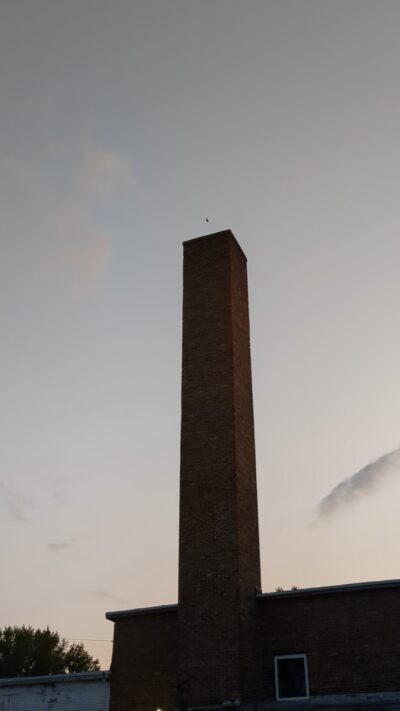
Chimney Swift at Smith Floral in Lansing. Photo by Chad Machinski
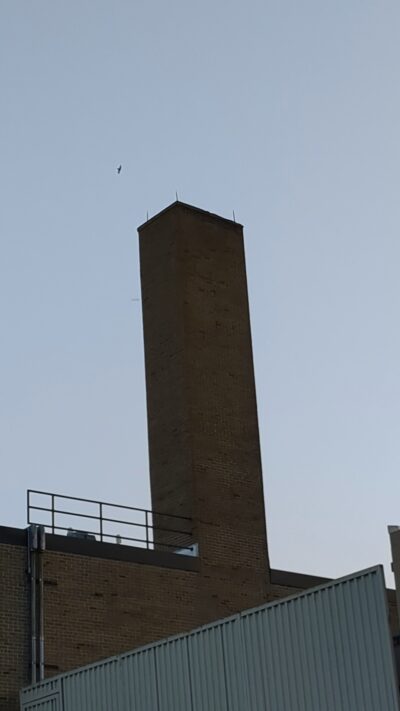
Chimney Swift at Kinawa Middle School in Okemos. Photo by Chad Machinski
To learn more about Michigan Audubon sanctuaries, visit michiganaudubon.org/conservation/bird-sanctuaries. If you want to volunteer at a Michigan Audubon sanctuary, please complete the Sanctuary Volunteer Interest Form.

Chad Machinski, MS
Conservation Manager
While Chad’s first love is botany, he doesn’t deny the intertwining nature of birds, plants, insects, and all other organisms we share the world with. His passion for the natural world began in his undergraduate time at the University of Michigan, taking several different forms along the way. His graduate studies at the University of Michigan allowed him to more closely examine the natural communities of Michigan and further understand the complex nature of ecosystems. His work as a Nichols Arboretum Caretaker while in school further enabled him to be directly involved in conservation work as he led workdays removing invasive plant species, performed trail maintenance, and guided tours. Chad can usually be found out in a park in a few ways: binoculars glued to his face, hunched over looking at plants, or flipping logs looking for snakes and salamanders.

